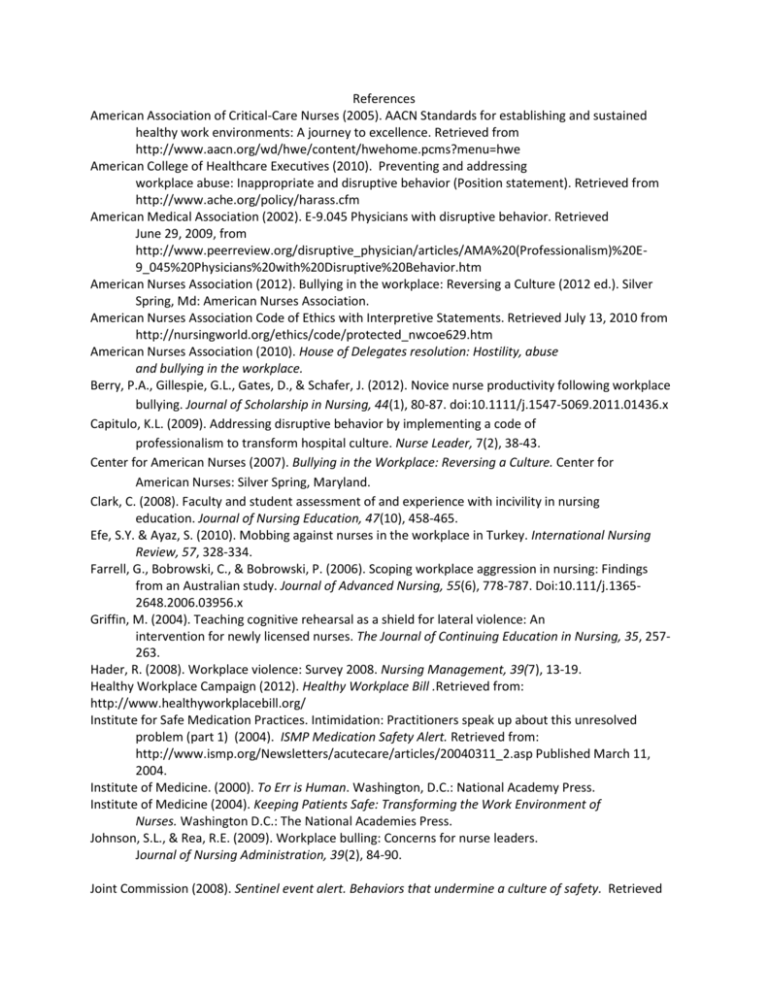References
advertisement

References American Association of Critical-Care Nurses (2005). AACN Standards for establishing and sustained healthy work environments: A journey to excellence. Retrieved from http://www.aacn.org/wd/hwe/content/hwehome.pcms?menu=hwe American College of Healthcare Executives (2010). Preventing and addressing workplace abuse: Inappropriate and disruptive behavior (Position statement). Retrieved from http://www.ache.org/policy/harass.cfm American Medical Association (2002). E-9.045 Physicians with disruptive behavior. Retrieved June 29, 2009, from http://www.peerreview.org/disruptive_physician/articles/AMA%20(Professionalism)%20E9_045%20Physicians%20with%20Disruptive%20Behavior.htm American Nurses Association (2012). Bullying in the workplace: Reversing a Culture (2012 ed.). Silver Spring, Md: American Nurses Association. American Nurses Association Code of Ethics with Interpretive Statements. Retrieved July 13, 2010 from http://nursingworld.org/ethics/code/protected_nwcoe629.htm American Nurses Association (2010). House of Delegates resolution: Hostility, abuse and bullying in the workplace. Berry, P.A., Gillespie, G.L., Gates, D., & Schafer, J. (2012). Novice nurse productivity following workplace bullying. Journal of Scholarship in Nursing, 44(1), 80-87. doi:10.1111/j.1547-5069.2011.01436.x Capitulo, K.L. (2009). Addressing disruptive behavior by implementing a code of professionalism to transform hospital culture. Nurse Leader, 7(2), 38-43. Center for American Nurses (2007). Bullying in the Workplace: Reversing a Culture. Center for American Nurses: Silver Spring, Maryland. Clark, C. (2008). Faculty and student assessment of and experience with incivility in nursing education. Journal of Nursing Education, 47(10), 458-465. Efe, S.Y. & Ayaz, S. (2010). Mobbing against nurses in the workplace in Turkey. International Nursing Review, 57, 328-334. Farrell, G., Bobrowski, C., & Bobrowski, P. (2006). Scoping workplace aggression in nursing: Findings from an Australian study. Journal of Advanced Nursing, 55(6), 778-787. Doi:10.111/j.13652648.2006.03956.x Griffin, M. (2004). Teaching cognitive rehearsal as a shield for lateral violence: An intervention for newly licensed nurses. The Journal of Continuing Education in Nursing, 35, 257263. Hader, R. (2008). Workplace violence: Survey 2008. Nursing Management, 39(7), 13-19. Healthy Workplace Campaign (2012). Healthy Workplace Bill .Retrieved from: http://www.healthyworkplacebill.org/ Institute for Safe Medication Practices. Intimidation: Practitioners speak up about this unresolved problem (part 1) (2004). ISMP Medication Safety Alert. Retrieved from: http://www.ismp.org/Newsletters/acutecare/articles/20040311_2.asp Published March 11, 2004. Institute of Medicine. (2000). To Err is Human. Washington, D.C.: National Academy Press. Institute of Medicine (2004). Keeping Patients Safe: Transforming the Work Environment of Nurses. Washington D.C.: The National Academies Press. Johnson, S.L., & Rea, R.E. (2009). Workplace bulling: Concerns for nurse leaders. Journal of Nursing Administration, 39(2), 84-90. Joint Commission (2008). Sentinel event alert. Behaviors that undermine a culture of safety. Retrieved Fromhttp://www.jointcommission.org/sentinel_event_alert_issue_40_behaviors_that_undermi ne_a_culture_of_safety/ Joint Commission (2009). Sentinel event alert. Leadership committed to safety. Retrieved from: http://www.jointcommission.org/sentinel_event_alert_issue_43_leadership_committed_to_saf ety/ Joint Commission (November 9, 2011). The term “disruptive behavior” is changed in the standards. Joint Commission Online. Retrieved from www.jointcommission.org Lewis, M. (2006). Nurse bullying: Organizational considerations in the maintenance and perpetuation of health care bullying cultures. Journal of Nursing Management, 14, 52-58. Longo, J. & Sherman, R. (2007). Leveling horizontal violence. Nursing Management, 38(3), 3437, 50, 51. MacIntosh, J. (2005). Experiences of workplace bullying in a rural area. Issues in Mental Health Nursing, 26, 893-910. Mardon, R.E., Khanna, K., Sorra, J., Dyer, N., & Famolaro, T. (2010). Exploring relationships between hospital patient safety culture and adverse events. Journal of Patient Safety, 6(4), 226-232. McGrath, J.M. (2005).Patient safety: Examples in the NICU. Journal of Perinatal and Neonatal Nursing. 7-8. McCall, E. (1996, April). Horizontal violence in nursing: The continuing silence. The Lamp, 28-31. McKenna, B., Smith, N., Poole, S., & Coverdale, J.H. (2003). Horizontal violence: Experiences of registered nurses in their first year of practice. Journal of Advanced Nursing 42, 90-96. Patient safety. Agency for Healthcare Research and Quality Glossary. Retrieved from: http://psnet.ahrq.gov/glossary.aspx?indexLetter=P. Porto, G., & Lauve, R. (2006, July/August). Disruptive clinician behavior: A persistent threat to patient safety. Patient Safety and Quality Healthcare. Retrieved from: http//: www.psqh.com/julaug06/disruptive.html Randle, J (2003). Bullying in the nursing profession. Journal of Advanced Nursing, 43, 395-401. Roberts, S.J. (1983) Oppressed Group Behavior: Implications for Nursing. Advances in Nursing Science, 5, 21-30. Rosenstein, A.H., & O’Daniel, M. (2005). Disruptive behaviors and clinical outcomes: Perceptions of nurses & physicians. American Journal of Nursing, 105(1). 54-64. Rosenstein, A.H., & O’Daniel, M. (2008). A survey of the impact of disruptive behaviors and communication defects on patient safety. The Joint Commission Journal on Quality and Patient Safety, 34(8), 464-471. Safety & Health Assessment and Research for Prevention Program (2011, April). Workplace bullying and disruptive behavior: What everyone needs to know. Report # 87-2-2011. Retrieved from: http://www.lni.wa.gov/Safety/Research/Files/Bullying.pdf Simons, S. (2008). Workplace bullying experienced by Massachusetts registered nurses and the relationship to intention to leave the organization. Advances in Nursing Science, 31(2), e48-e59. Simons, SR., & Mawn, B. (2010). Bulling in the workplace: A qualitative study of newly licensed registered nurses. AAOHN Journal, 58(7), 305-311. Skillings, L.N. (1992). Perceptions and feelings of nurses about horizontal violence as an expression of oppressed group behavior. In J.L. Thompson, D.G. Allen, & L Rodrigues-Fisher (Eds.), Critique, resistance, and action: Working papers in the politics of nursing (pp. 167-185). New York: National League for Nursing Press. Studer, Q. (2008). Results that last. Hoboken, New Jersey: John Wiley & Sons, Inc. Thomas, S.P. (2003). Anger: The mismanaged emotion. Dermatology Nursing, 15, 351-357. Retrieved September 22, 2003 from Ovid database. Veltman, L.L. (2007). Disruptive behavior in obstetrics: A hidden threat to patient safety. American Journal of Obstetrics and Gynecology, 196(6), 587.e1-587.e5. Vessey, J.A., Demarco, R.F., Gaffney, D.A., & Budin, W.C. (2009). Bullying of staff registered nurses in the workplace: A preliminary study for developing personal and organizational strategies for the transformation of hostile to healthy workplace environments. Journal of Professional Nursing, 25(5), 299-306. VitalSmarts. (2005). Silence kills: The seven crucial conversation in healthcare. Weber, D.O. (2004). Poll results: Doctors’ disruptive behavior disturbs physician leaders. The Physician Executive, 30(5), 6-14. Wilson, B.L., Diedrich, A., Pheps, C.L., Choi, M. (2011). Bullies at work: The impact of horizontal hostility in the hospital setting and intent to leave. Journal of Nursing Administration, 41(11), 453-458. Yildirim, A., & Yildirim, D. (2007). Mobbing in the workplace by peers and managers: Mobbing experienced by nurses working in healthcare facilities in Turkey and its effect on nurses. Journal of Clinical Nurses, 16(8), 1444-1453.




